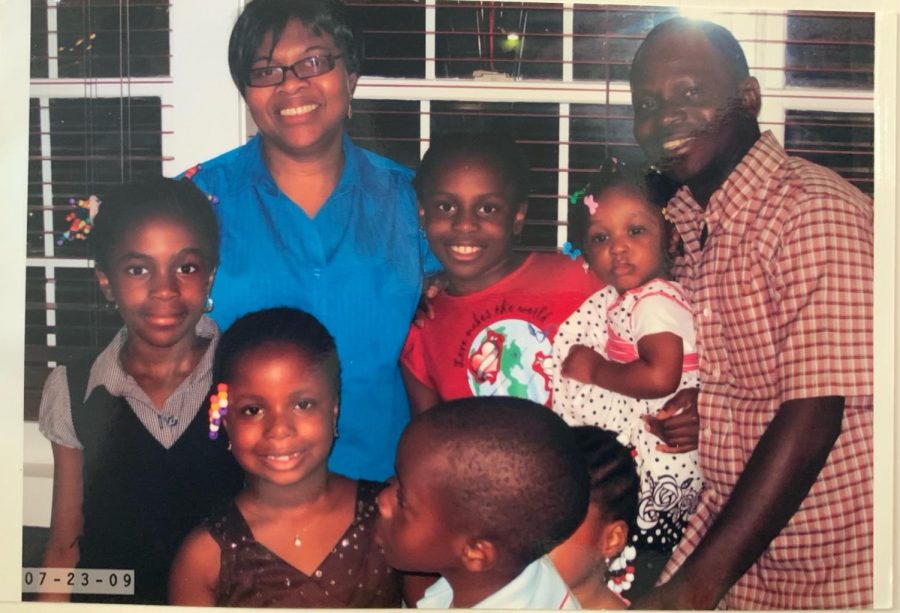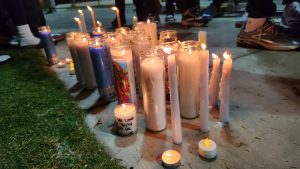Why Black women are dying of breast cancer at higher rates than White women
There is a 2.6 percent chance a woman will die from breast cancer. Black women make up a large portion of that small percentage, with a 40 percent higher death rate.
Hope Egie (left) smiles in a family photo with her mother Isimeme Akoko (upper left).
October 30, 2020
Hope Egie, junior business administration major, was 8 years old when her mother, Isimeme Akoko was diagnosed with Stage 4 breast cancer. With her being so young at the time, Egie does not remember when her mother was first diagnosed, but she began to understand the process more as she got older.
“My dad didn’t discuss it with me until I got older, but she felt something weird and the doctor didn’t notice it at first,” Egie said. “It wasn’t until after we switched doctors when she actually found that it was breast cancer and that her original doctor had missed the diagnosis.”
The mother of four fought a year-long battle before she died within a year of chemotherapy and radiation treatment at 44 years old.
In the average human lifetime, about one in eight women are infected with breast cancer, the second most common cancer diagnosed among American women according to Breastcancer.org. Although only 12 percent of women are diagnosed with breast cancer in their lifetime, the disease has affected everyone in the nation, whether they personally suffered from it or witnessed a loved one fight through it.
There is a 2.6 percent chance a woman will die from breast cancer. Black women specifically make up a large portion of that small percentage of women. They have a 40 percent higher death rate than White women according to the Centers for Disease Control and Prevention (CDC).
When Black women are infected with breast cancer, they are two times more likely to get triple-negative breast cancer (TNBC), an aggressive form of breast cancer that often comes back after treatment, in comparison to White women.
TNBC is different from other forms of breast cancer because of its failure to respond to hormonal therapy, according to Patience Ekeocha, nurse practitioner and associate director of the Morgan State University Health Center.
“Triple-negative subtype is basically the breast cancer that tests negative for estrogen receptors. This cancer does not respond to hormonal therapy. You can use hormonal therapies for other breast cancers, but this cancer does not respond to it,” Ekeocha said.
The Johns Hopkins University School of Medicine’s Department of Oncology and the Sidney Kimmel Comprehensive Cancer Center at Johns Hopkins studied the racial disparity and triple negative breast cancer among Black women. The studies reported some of the characteristics of TNBC in Black women are larger tumors and further advanced stages at the diagnosis compared to White women.
There has been some progress with learning more about triple negative breast cancer, according to Karen E. Jackson, four-time breast cancer survivor and CEO of Sisters Network, a national African American breast cancer survivorship organization. Jackson said that doctors didn’t even have a name for the type of cancer in the ‘90s.
“All they would say is that African American women were too lazy, we didn’t want to take care of our health,” Jackson said. “It was all about what we didn’t do and not that the particular cancer was aggressive.”
As reported by Johns Hopkins University, 30 percent of Black women diagnosed with breast cancer are likely to have TNBC, compared to 16 percent of White women.
Otis Brawley, Bloomberg Distinguished Professor of Oncology from Johns Hopkins University, argued that the claim that Black women get TNBC more than White women is an exaggeration and the focus should be on the number of Black women that do not seek medical attention.
“The biggest problem is that black women with breast cancer are less likely to get optimal therapy and actually the therapy issues are worse for the 76 percent of Black women who do not have triple negative breast cancer,” Brawley said.
While this could be the case for those women, there have been several cases where Black women sought medical attention and it was not enough. In Akoko’s case, her doctors dismissed her health concerns and did not take her seriously.
“Her doctor would usually either write a prescription for her to take for the time being or they’d just say, ‘It’s a side effect, it’s normal’ even though she would express she felt like it wasn’t something that was normal,” Egie said. “They’d kind of like push it off as something like ‘Oh, she’s exaggerating’ or it’s something that’s not that serious for the time being.’”
In situations like, some believe that Black women’s health concerns are not taken as seriously as they should be until it is too late.
“There’s a lack of emphasis on getting people good high-quality care once diagnosed,” Brawley said. “Those whose lives could have been saved, the majority die because they don’t get good high-quality treatment.”
This story is a part of Black Health Matters, a year-long reporting program through The Poynter Institute’s College Media Project. The project’s objective: to tell health related stories through the lens of Black college students, while examining possible solutions.












Yvonne Bronner • Nov 2, 2020 at 9:20 am
This is excellent and much needed. I have longed for seeing us communicate to our community the health news that can help to make us all healthier. THANKS and keep up the good work!!!